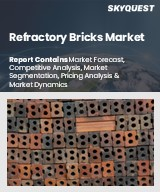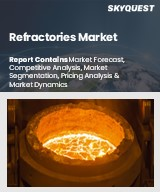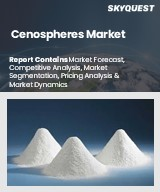
|
시장보고서
상품코드
1838216
내화 벽돌 시장 : 규모, 점유율, 성장 분석, 원재료별, 용도별, 제조 공정별, 형상별, 특성별, 지역별 산업 예측(2025-2032년)Refractory Bricks Market Size, Share, and Growth Analysis, By Raw Material (Fireclay, High Alumina), By Application (Iron and Steel Industry, Cement Industry), By Manufacturing Process, By Shape, By Property, By Region - Industry Forecast 2025-2032 |
||||||
세계의 내화 벽돌 시장 규모는 2023년에 343억 달러로 평가되었고, 2024년 366억 7,000만 달러에서 2032년에는 625억 3,000만 달러로 성장해 예측 기간(2025-2032년)의 CAGR은 6.9%를 나타낼 전망입니다.
세계의 내화 벽돌 시장은 주로 극단적인 온도에 견디는 재료를 필요로 하는 철강, 시멘트, 유리, 비철금속 등 주요 산업에서 수요가 증가함에 따라 강력한 성장을 이루고 있습니다. 신흥국의 급속한 산업화는 인프라와 에너지 부문의 진보에 견인되어 소비를 더욱 촉진하고 있습니다. 동시에 환경 규제 강화의 영향을 받아 지속 가능하고 환경 친화적인 내화물 개발 동향도 두드러집니다. 제조업체는 품질 향상과 폐기물 최소화를 위해 자동화 및 3D 프린팅과 같은 혁신적인 생산 기술을 채택하고 있습니다. 그러나 이 시장은 원재료의 높은 비용과 생산 공정의 에너지 집약적인 성질, 대체 재료와의 경쟁, 비용 효율성을 방해하는 엄격한 배출 규제 등의 과제에 직면하고 있습니다.
자주 묻는 질문
목차
서론
- 조사의 목적
- 조사 범위
- 정의
조사 방법
- 정보 조달
- 2차와 1차 데이터의 방법
- 시장 규모 예측
- 시장의 전제조건과 제한
주요 요약
- 세계 시장 전망
- 공급과 수요 동향 분석
- 부문별 기회 분석
시장 역학과 전망
- 시장 개요
- 시장 규모
- 시장 역학
- 성장 촉진요인과 기회
- 성장 억제요인과 과제
- Porter's Five Forces 분석
주요 시장 인사이트
- 중요 성공 요인
- 경쟁도
- 주요 투자 기회
- 시장 생태계
- 시장의 매력 지수(2024년)
- PESTEL 분석
- 거시경제지표
- 밸류체인 분석
- 가격 분석
내화 벽돌 시장 규모 : 원재료별&CAGR(2025-2032년)
- 시장 개요
- 내화점토
- 고알루미나
- 실리콘 카바이드
- 마그네시아
- 지르코니아
내화 벽돌 시장 규모 : 용도별&CAGR(2025-2032년)
- 시장 개요
- 철강 산업
- 시멘트 산업
- 유리 산업
- 비철금속 산업
- 석유화학 산업
내화 벽돌 시장 규모 : 제조 공정별&CAGR(2025-2032년)
- 시장 개요
- 건조 압축
- 압출
- 사출 성형
- 슬립 캐스팅
- 증착
내화 벽돌 시장 규모 : 형상별&CAGR(2025-2032년)
- 시장 개요
- 표준 벽돌
- 특수 형상
- 일체형 내화물
내화 벽돌 시장 규모 : 특성별&CAGR(2025-2032년)
- 시장 개요
- 고온 저항성
- 내화학성
- 내마모성
- 내식성
- 열전도율
내화 벽돌 시장 규모 : 지역별&CAGR(2025-2032년)
- 북미
- 미국
- 캐나다
- 유럽
- 독일
- 스페인
- 프랑스
- 영국
- 이탈리아
- 기타 유럽
- 아시아태평양
- 중국
- 인도
- 일본
- 한국
- 기타 아시아태평양
- 라틴아메리카
- 브라질
- 기타 라틴아메리카
- 중동 및 아프리카
- GCC 국가
- 남아프리카
- 기타 중동 및 아프리카
경쟁 정보
- 상위 5개사 비교
- 주요 기업 시장 포지셔닝(2024년)
- 주요 시장 기업이 채용한 전략
- 최근 시장 동향
- 기업 시장 점유율 분석(2024년)
- 주요 기업 프로파일
- 기업의 상세
- 제품 포트폴리오 분석
- 기업의 부문별 점유율 분석
- 수익의 전년대비 비교(2022-2024년)
주요 기업 프로파일
- RHI Magnesita(Netherlands)
- Vesuvius(United Kingdom)
- Saint-Gobain SEFPRO(France)
- Krosaki Harima Corporation(Japan)
- Imerys(France)
- Calderys(France)
- Harbison Walker International(USA)
- Resco Products, Inc.(USA)
- DSF Refractories & Minerals Ltd(United Kingdom)
- TRL Krosaki Refractories Ltd(India)
- IFGL Refractories Ltd(India)
- Ganesha's Refractories(India)
- Jindal Refractories(India)
- Horizon Refractories(India)
- Shree Tirupati Refractories & Minerals(India)
- Haznedar Fire Bricks(튀르키예)
- Konya Chrome Magnesite Brick Manufacturing Industry(Turkey)
- Kutahya Magnesite Industry(Turkey)
- Raja Insulation & Refractories Pvt Ltd(India)
- Mahavir Refractories Corporation(India)
결론과 권고
KTH 25.10.23Global Refractory Bricks Market size was valued at USD 34.3 billion in 2023 and is poised to grow from USD 36.67 billion in 2024 to USD 62.53 billion by 2032, growing at a CAGR of 6.9% during the forecast period (2025-2032).
The global refractory bricks market is experiencing robust growth, primarily fueled by heightened demand across key industries, including steel, cement, glass, and non-ferrous metals, which require materials capable of enduring extreme temperatures. The rapid industrialization in emerging economies further bolsters consumption, driven by infrastructure and energy sector advancements. Concurrently, there is a noticeable trend towards the development of sustainable and eco-friendly refractories, influenced by tighter environmental regulations. Manufacturers are increasingly adopting innovative production techniques, like automation and 3D printing, to enhance quality and minimize waste. However, the market faces challenges, including the high costs of raw materials and the energy-intensive nature of production processes, along with competition from alternative materials and stringent emission norms, which hinder cost efficiency.
Top-down and bottom-up approaches were used to estimate and validate the size of the Global Refractory Bricks market and to estimate the size of various other dependent submarkets. The research methodology used to estimate the market size includes the following details: The key players in the market were identified through secondary research, and their market shares in the respective regions were determined through primary and secondary research. This entire procedure includes the study of the annual and financial reports of the top market players and extensive interviews for key insights from industry leaders such as CEOs, VPs, directors, and marketing executives. All percentage shares split, and breakdowns were determined using secondary sources and verified through Primary sources. All possible parameters that affect the markets covered in this research study have been accounted for, viewed in extensive detail, verified through primary research, and analyzed to get the final quantitative and qualitative data.
Global Refractory Bricks Market Segments Analysis
Global Refractory Bricks Market is segmented by Raw Material, Application, Manufacturing Process, Shape, Property and region. Based on Raw Material, the market is segmented into Fireclay, High Alumina, Silicon Carbide, Magnesia and Zirconia. Based on Application, the market is segmented into Iron and Steel Industry, Cement Industry, Glass Industry, Non-Ferrous Metal Industry and Petrochemical Industry. Based on Manufacturing Process, the market is segmented into Dry Pressing, Extrusion, Injection Molding, Slip Casting and Vapor Deposition. Based on Shape, the market is segmented into Standard Bricks, Special Shapes and Monolithic Refractories. Based on Property, the market is segmented into High Temperature Resistance, Chemical Resistance, Wear Resistance, Corrosion Resistance and Thermal Conductivity. Based on region, the market is segmented into North America, Europe, Asia Pacific, Latin America and Middle East & Africa.
Driver of the Global Refractory Bricks Market
The expanding focus on infrastructure development is driving up the demand for essential materials such as cement, glass, steel, and various non-metallic minerals. Refractory bricks play a crucial role in the production of these materials, as their manufacturing processes require significant heat resistance. Consequently, as the demand for these core products continues to rise, it is anticipated that the refractory industry will experience corresponding growth. This trend underscores the vital importance of refractory bricks in supporting the increasing requirements of diverse sectors, further solidifying their position in the global market.
Restraints in the Global Refractory Bricks Market
The production of refractory bricks requires high-temperature firing processes, which demand considerable energy and lead to significant CO2 emissions. These environmentally taxing procedures raise serious ecological concerns, resulting in heightened compliance costs for manufacturers. Additionally, the stringent emission regulations in various regions pose challenges for market growth, as companies must navigate increased operational expenses and invest in cleaner technologies. Consequently, these factors may restrain the overall development of the global refractory bricks market, as the industry grapples with the dual pressures of maintaining production efficiency while adhering to evolving environmental standards.
Market Trends of the Global Refractory Bricks Market
The Global Refractory Bricks market is experiencing a notable trend towards eco-friendly and sustainable materials as manufacturers strive to align with stringent environmental regulations. There is a growing demand for low-carbon refractory bricks, which not only reduce emissions but also optimize energy consumption during production processes. This shift is driven by industries seeking more responsible and sustainable production methods, as businesses increasingly prioritize environmental stewardship. As a result, innovations in sustainable brick technologies are gaining momentum, reflecting a broader commitment to reducing the ecological footprint and enhancing overall process efficiency within the refractory material sector.
Table of Contents
Introduction
- Objectives of the Study
- Scope of the Report
- Definitions
Research Methodology
- Information Procurement
- Secondary & Primary Data Methods
- Market Size Estimation
- Market Assumptions & Limitations
Executive Summary
- Global Market Outlook
- Supply & Demand Trend Analysis
- Segmental Opportunity Analysis
Market Dynamics & Outlook
- Market Overview
- Market Size
- Market Dynamics
- Drivers & Opportunities
- Restraints & Challenges
- Porters Analysis
- Competitive rivalry
- Threat of substitute
- Bargaining power of buyers
- Threat of new entrants
- Bargaining power of suppliers
Key Market Insights
- Key Success Factors
- Degree of Competition
- Top Investment Pockets
- Market Ecosystem
- Market Attractiveness Index, 2024
- PESTEL Analysis
- Macro-Economic Indicators
- Value Chain Analysis
- Pricing Analysis
Global Refractory Bricks Market Size by Raw Material & CAGR (2025-2032)
- Market Overview
- Fireclay
- High Alumina
- Silicon Carbide
- Magnesia
- Zirconia
Global Refractory Bricks Market Size by Application & CAGR (2025-2032)
- Market Overview
- Iron and Steel Industry
- Cement Industry
- Glass Industry
- Non-Ferrous Metal Industry
- Petrochemical Industry
Global Refractory Bricks Market Size by Manufacturing Process & CAGR (2025-2032)
- Market Overview
- Dry Pressing
- Extrusion
- Injection Molding
- Slip Casting
- Vapor Deposition
Global Refractory Bricks Market Size by Shape & CAGR (2025-2032)
- Market Overview
- Standard Bricks
- Special Shapes
- Monolithic Refractories
Global Refractory Bricks Market Size by Property & CAGR (2025-2032)
- Market Overview
- High Temperature Resistance
- Chemical Resistance
- Wear Resistance
- Corrosion Resistance
- Thermal Conductivity
Global Refractory Bricks Market Size & CAGR (2025-2032)
- North America (Raw Material, Application, Manufacturing Process, Shape, Property)
- US
- Canada
- Europe (Raw Material, Application, Manufacturing Process, Shape, Property)
- Germany
- Spain
- France
- UK
- Italy
- Rest of Europe
- Asia Pacific (Raw Material, Application, Manufacturing Process, Shape, Property)
- China
- India
- Japan
- South Korea
- Rest of Asia-Pacific
- Latin America (Raw Material, Application, Manufacturing Process, Shape, Property)
- Brazil
- Rest of Latin America
- Middle East & Africa (Raw Material, Application, Manufacturing Process, Shape, Property)
- GCC Countries
- South Africa
- Rest of Middle East & Africa
Competitive Intelligence
- Top 5 Player Comparison
- Market Positioning of Key Players, 2024
- Strategies Adopted by Key Market Players
- Recent Developments in the Market
- Company Market Share Analysis, 2024
- Company Profiles of All Key Players
- Company Details
- Product Portfolio Analysis
- Company's Segmental Share Analysis
- Revenue Y-O-Y Comparison (2022-2024)
Key Company Profiles
- RHI Magnesita (Netherlands)
- Company Overview
- Business Segment Overview
- Financial Updates
- Key Developments
- Vesuvius (United Kingdom)
- Company Overview
- Business Segment Overview
- Financial Updates
- Key Developments
- Saint-Gobain SEFPRO (France)
- Company Overview
- Business Segment Overview
- Financial Updates
- Key Developments
- Krosaki Harima Corporation (Japan)
- Company Overview
- Business Segment Overview
- Financial Updates
- Key Developments
- Imerys (France)
- Company Overview
- Business Segment Overview
- Financial Updates
- Key Developments
- Calderys (France)
- Company Overview
- Business Segment Overview
- Financial Updates
- Key Developments
- HarbisonWalker International (USA)
- Company Overview
- Business Segment Overview
- Financial Updates
- Key Developments
- Resco Products, Inc. (USA)
- Company Overview
- Business Segment Overview
- Financial Updates
- Key Developments
- DSF Refractories & Minerals Ltd (United Kingdom)
- Company Overview
- Business Segment Overview
- Financial Updates
- Key Developments
- TRL Krosaki Refractories Ltd (India)
- Company Overview
- Business Segment Overview
- Financial Updates
- Key Developments
- IFGL Refractories Ltd (India)
- Company Overview
- Business Segment Overview
- Financial Updates
- Key Developments
- Ganesha's Refractories (India)
- Company Overview
- Business Segment Overview
- Financial Updates
- Key Developments
- Jindal Refractories (India)
- Company Overview
- Business Segment Overview
- Financial Updates
- Key Developments
- Horizon Refractories (India)
- Company Overview
- Business Segment Overview
- Financial Updates
- Key Developments
- Shree Tirupati Refractories & Minerals (India)
- Company Overview
- Business Segment Overview
- Financial Updates
- Key Developments
- Haznedar Fire Bricks (Turkey)
- Company Overview
- Business Segment Overview
- Financial Updates
- Key Developments
- Konya Chrome Magnesite Brick Manufacturing Industry (Turkey)
- Company Overview
- Business Segment Overview
- Financial Updates
- Key Developments
- Kutahya Magnesite Industry (Turkey)
- Company Overview
- Business Segment Overview
- Financial Updates
- Key Developments
- Raja Insulation & Refractories Pvt Ltd (India)
- Company Overview
- Business Segment Overview
- Financial Updates
- Key Developments
- Mahavir Refractories Corporation (India)
- Company Overview
- Business Segment Overview
- Financial Updates
- Key Developments



















